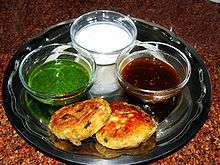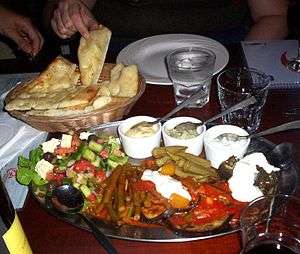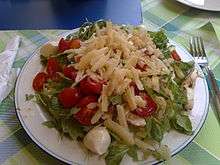Travel as a vegetarian
Vegetarians and vegans can eat quite well in most countries. While the traditional cuisine and style of eating in many countries can make it a bit difficult for vegetarians or vegans to find food without animal products in it, most cultures have at least a few vegetarian dishes, and restaurants are often willing to leave out or substitute animal ingredients. Although plant-based diets are increasingly common, several locations lack a strong cultural basis for vegetarian eating or understand "vegetarianism" differently. Being informed before you go abroad is necessary to maintain an animal-free diet.

Planning

If your diet is important to you then it is imperative to take your diet into consideration when planning your trip. As a conscientious traveler, it's much better to put the work in beforehand to avoid stressing yourself trying to find food while traveling, as well as avoiding placing the burden of feeding you on a people and culture that may not know how to accommodate you. Where will you be going? There will be a greater variety of food available in big urban centers than there will be in rural areas. If you want to visit a tiny village in rural Brazil, fine, but be prepared that it may greatly limit your diet.
Research the cuisine for the places where you are going. There will be a couple of vegetable/grain dishes almost everywhere, so you'll have something to order in restaurants. This will also give you an idea of local cooking techniques; oftentimes, innocent-looking vegetable dishes will be cooked in a meat stock, or contain fish sauce (see "Non-vegetarian items in vegetable dishes" below).
Look up lists of vegetarian restaurants and grocery stores in the area where you'll be staying and check the destination guides for the area you will be visiting for information. Look for local vegetarian organizations in the area you'll be visiting.
Among countries in which vegetarianism and veganism is not the norm, those in the West tend to be the most accommodating, and even non-veg restaurants, particularly in the Netherlands, Denmark, the US and the UK, generally offer several vegetarian options and the staff are likely to be better prepared to answer questions regarding what dishes are vegetarian-friendly. Mediterranean countries, such as France, Italy and Greece are known for making delicious composed salads. Some of them have ham or anchovies in them, but many do not. In Romania and other places where the Orthodox Church is strong, a "fasting" or "Lenten" diet is generally vegan and alcohol-free, although in some countries, such as Serbia, the diet may be interpreted as including fish or shellfish and beer (but never meat, eggs, or milk). In the Eastern Mediterranean, North Africa, and places like Yemen, you can easily make a satisfying meal out of mezes (mezedes in Greek)—small plates and spreads such as falafel; tabbouleh; baba ghanouj; ezme; pickled turnips; hummus; spicy carrots; Arab, Greek, Turkish, Israeli, or Moroccan salad; foul (fava bean paste); etc.
Other countries, such as India and Taiwan, have a tradition of vegetarianism, so finding suitable meals in these places will not be a problem.
In China, seek out mock-meat dishes (but make sure the preparation is completely vegetarian if the establishment is not), Buddha's Delight, and places such as monasteries that serve only Buddhist vegetarian cuisine. But don't assume that a restaurant that makes vegetable as well as meat dishes might not include some pork or dried shrimps in a vegetable dish (see below). Similarly, due to a long history of Mahayana Buddhist influences in Japan and South Korea, there are also vegetarian restaurants to cater to more devout Buddhists, and in many rural areas the nearest Buddhist temple will be your best bet in seeking vegetarian food.
It's wise to bring some kind of emergency snacks with you in case you find yourself in a situation with no vegetarian food available. This is especially likely to happen when you're in transit, for instance at a bus station or on a long train ride. Pick something non-perishable, filling, and easy to transport. Clif bars or Luna bars are a good choice—they're calorie-dense and full of nutrients, and most are vegan.
Non-vegetarian items in vegetable dishes
In many countries, seemingly vegetarian dishes can actually contain meat, in the form of sauces, seasonings, broths, and even just pieces of meat mixed in to add flavor. Don't assume that a dish doesn't have meat just because the menu doesn't mention it. Something innocuous-looking like sauteed vegetables or even bread may have meat added in some parts of the world, and it's hard to tell if a soup has meat broth without asking. Learn what types of hidden animal products are common in the country you're visiting, and if in doubt, ask before ordering.
In parts of Southeast Asia, it can be challenging to find completely vegetarian food. Belacan—shrimp paste—is generally an ingredient in the rempah (spice paste) of Malaysian dishes, even when you can't taste it separately. Similarly, in Thailand and Vietnam, there is very often some fish sauce in an otherwise vegetable dish. In those countries and also Indonesia, it is common for little dried shrimp to also show up in vegetable dishes (these are common in some regional Chinese cuisines, too). So finding strictly vegetarian food in these countries may require extra effort, and where you can find South Indian vegetarian or specifically Buddhist vegetarian food, you may want to avail yourself of the opportunity.
Japanese food often uses dashi, a stock which is commonly made from bonito flakes but can be made from kombu (kelp). Sometimes, sardines or mushrooms are used, instead. If you are not a pescetarian, try to determine to your satisfaction whether exclusively vegetable ingredients were used to make the dashi.
In Korea, the basically vegetable staple, kimchi, very commonly uses dried shrimp in its preparation, or/and may use other non-vegetable ingredients, depending on regional traditions within Korea. It is possible to find kimchi that is strictly vegetarian, but do not assume the kimchi that is put in front of you is truly vegetarian unless you have done due diligence.
In Europe—France and Spain especially—make sure when you order composed salads that you know whether they include ham, bacon/lardons, salami/mortadella, anchovies, and also eggs or/and cheese if you are a strict vegan.
In the United States, especially the South, cooked vegetables are often made with lard or butter.
Language and cultural issues
In some countries and cultures (especially developing countries) vegetarianism/veganism is rare or even nonexistent.
Food culture is very important in many countries, and refusal to participate fully in the meal may make you appear culturally insensitive and snobbish. In any country, it's possible that you will insult your hosts when you turn down their food, especially if it was prepared specially for you. If you know you will be received as a guest somewhere, make your diet known to your hosts in advance. If you know of any local dishes that you can eat, it may be helpful to name them as examples.
In many places the word "vegetarian" (let alone "vegan") is not known or commonly used and thus you will have to use different expressions. You may also run into a language barrier, as sometimes the word you think means "meat" does not mean "all edible things derived from dead animals". E.g. the English word "meat" is usually understood to exclude (nearly) all marine animals and some varieties of Spanish don't include chicken in the word "carne", either, your dictionary saying "carne" means "meat" notwithstanding. It may be less ambiguous to (if you are able to) say you don't eat animals or use one of the local cultural equivalents (i.e. "Buddhist diet") to say what you want to say. If you don't eat eggs, you should mention this specifically—in many countries eggs are considered vegetarian.
The International Vegetarian Union has very brief listings of what vegans eat/don't eat, in many different languages. All you have to do is to show the right page to the restaurant staff.
Still, sometimes things happen that you cannot anticipate or in spite of your efforts to make your restrictions known, what is prepared is not vegetarian-friendly. Have an explanation with you and be prepared to repeat it. If you did mention your diet ahead of time, politely referring back to it can at least assure your guests that you are not refusing because of the way the food looks, smells, etc. Be polite and apologetic as you would anywhere, but also be prepared to accept that your host may still be offended or hurt.
If you're a vegetarian for non-religious ethical reasons, in places with a language barrier or strong food/host tradition it's usually best to refrain from explaining out your beliefs and go with something inarguable (medical reasons, something vaguely religious or cultural). Be very careful with making up fake reasons if you know you will or hope to see your hosts much in the future. In some cultures, there may be a vegetarian tradition of some kind that you can compare your diet to. In countries with Buddhist sub-populations, some vegetarian travellers find that calling their diet "Buddhist" is the simplest way to explain it.

Be as considerate as you are in your home country. If a restaurant does not have any vegetarian dishes or you realize that your attempts to explain are simply not getting anywhere, kindly apologize for taking up their time and move on. Getting loud, insulting the staff, or becoming indignant will not help the situation and will certainly not change their menu. Your diet is your own responsibility.
When all else fails, find a grocery store or local vegetable market. You can make a meal yourself with a camping stove or kitchen.
Making concessions
Many people who are vegetarians for personal reasons such as promoting general health make the decision to "leave their diet at home", meaning they make concessions while traveling. These may range from permitting a single dish just to get by to a complete vacation from one's usual diet. There are a variety of reasons for making this choice. In social situations and especially when you are being hosted, you can make a very bad impression (as outlined above) by refusing food. Even if you are alone, some vegetarians prefer to forego their diet while traveling so that they can fully immerse themselves in the culture, including food culture, or simply because they want to try famous dishes, which will often contain meat.
If you are vegetarian in your home country for reasons related to the treatment of animals, you may find that these issues are less severe in your destination. In many parts of the world, people still raise their livestock in the old-fashioned way, without genetic modifications, feeding them steroids, penning them up in small quarters, etc. It can also be unwise to judge people who depend on eating animals for survival, as opposed to the overindulgence you may be used to back home.
While a hiatus from your diet is something to think about, it is certainly not for everyone. There are a wide variety of reasons to be vegetarian, some of which permit this sort of thing and others that do not. Consider your own reasons and weigh them against your travel wishes to reach your own decision regarding whether this option may be viable for you.
Air travel
Most full service airlines that serve meals on-board offer a vegetarian choice. You should request the vegetarian meal at the time of your reservation, and to be sure reconfirm with the airline 72 hours before departure. If you book online and there is no option to select your meal, you should call the airline. If you forget at the time of booking, there is little prospect of requesting one at check-in; however, it always pays to ask on the plane, as often there can be a spare meal that meets your requirements. If not, the meal without the heated component can often be vegetarian. Be warned that in economy class, vegetarian meals served on airplanes are often nothing but overcooked steamed or boiled vegetables without seasoning.
Full service airlines use codes internally with their caterers to select meal types. The codes applicable to vegetarians and vegans are:
- VGML – Strict/Pure Vegetarian (Vegan) – Usually the default vegetarian special meal.
- VLML – Lacto-Ovo Vegetarian / Western Vegetarian
- AVML – Asian Vegetarian – Spicy Indian food
- VJML – Vegetarian Jain Meal (no eggs, mushrooms or root vegetables, but may contain dairy)
- VOML – Chinese Vegetarian (Vegan)
- RVWL – Raw Vegetarian (Vegan)
- FPML – Fruit Platter (Vegan).
At airports removed from the airline's home ports the food can depend more on the catering available at the remote airport than the airline. Sometimes the different vegetarian styles will give different meals, but it is quite common for a VGML to be served, even if you order a VLML.
Discount airlines, and some full service airlines on short sectors do not serve food or have food sold from a trolley. Usually there is a vegetarian option, but you can usually check the inflight menu in advance on the website, or third party sites that have meal information.
It is an unfortunate fact of flying that sometimes the full service airline loses a meal order, or the salad sandwich on the discount airline is sold out, or not available on a flight. It's always a good idea to take snacks on board just in case.
Other information
There are a few cities in the world that are completely vegetarian, including the Indian holy cities of Haridwar and Rishikesh. Non-vegetarian food is prohibited in those places, but sometimes eggs and products containing eggs can be sold in the outskirts. As well, if you buy cheese, it may contain rennet, and some beverages/yoghurts/ice creams may contain coloring agents from insects. Cosmetics and similar products may be tested on animals while clothing and footwear made from leather are commonly sold, too.
Some apps and websites such as HappyCow and OpenVegeMap can also be helpful when finding vegan and vegetarian restaurants where you go.

